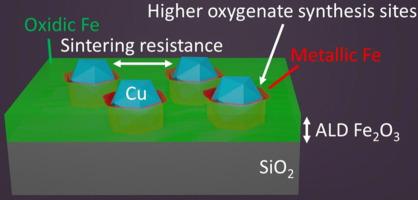Journal of Catalysis ( IF 6.5 ) Pub Date : 2021-09-22 , DOI: 10.1016/j.jcat.2021.09.015 Arun S. Asundi 1 , Sindhu S. Nathan 1 , Jiyun Hong 2 , Adam S. Hoffman 2 , Makenna Pennel 3 , Simon R. Bare 2 , Stacey F. Bent 1

|
The conversion of syngas to higher oxygenates is an important step in the pathway towards the long-term sustainable production of fuels and chemicals. Mixed Cu/Fe catalysts combine metals with different CO activation characteristics, a property that makes them promising candidates for higher oxygenate production. However, Cu/Fe catalysts suffer from instability due to sintering and phase separation, and the active sites for higher oxygenate formation on these materials are not well understood. In this work, we use atomic layer deposition (ALD) to modify silica-supported Cu nanoparticles with monolayer precise amounts of Fe2O3 and study the effects on catalyst structure, reactivity, and stability. We demonstrate that the Fe2O3 ALD process is inherently selective towards deposition on the SiO2 surface versus the Cu nanoparticles. As a result, a sufficiently thick Fe2O3 layer surrounding the Cu nanoparticles acts as a barrier against Cu migration, preventing catalyst deactivation through sintering without covering the Cu. In syngas conversion reactions, we find that higher oxygenate selectivity increases with Fe2O3 loading at low and intermediate ALD cycle numbers. Furthermore, using in situ X-ray absorption spectroscopy, we demonstrate that the Fe near the Cu nanoparticles is reduced to a metallic state under reaction conditions. From these measurements, we identify these metallic Cu/Fe interfaces as the active sites for higher oxygenate formation, which are most abundant at intermediate Fe2O3 ALD cycle numbers. As the Fe2O3 loading increases, higher oxygenate selectivity falls, resulting from encapsulation of the Cu nanoparticles by thick Fe2O3 layers. The results demonstrate how thickness-controlled ALD Fe2O3 can be used as both a promoter and stabilizer of Cu-based higher oxygenate synthesis catalysts.
中文翻译:

确定通过原子层沉积 Fe2O3 促进和稳定的 Cu 催化剂中的高含氧量合成位点
将合成气转化为更高的含氧化合物是实现燃料和化学品长期可持续生产的重要一步。混合铜/铁催化剂结合了具有不同 CO 活化特性的金属,这一特性使它们成为提高含氧化合物产量的有希望的候选者。然而,Cu/Fe 催化剂由于烧结和相分离而具有不稳定性,并且在这些材料上形成更高含氧量的活性位点尚不清楚。在这项工作中,我们使用原子层沉积 (ALD) 用单层精确量的 Fe 2 O 3修饰二氧化硅负载的 Cu 纳米粒子,并研究对催化剂结构、反应性和稳定性的影响。我们证明 Fe 2 O 3ALD 工艺对在 SiO 2表面上的沉积具有固有的选择性,而不是在 Cu 纳米颗粒上。结果,围绕Cu纳米颗粒的足够厚的Fe 2 O 3层充当防止Cu迁移的屏障,防止催化剂在不覆盖Cu的情况下通过烧结失活。在合成气转化反应中,我们发现较高的氧化选择性随 Fe 2 O 3 的增加而增加在低和中等 ALD 循环数下加载。此外,使用原位 X 射线吸收光谱,我们证明了 Cu 纳米颗粒附近的 Fe 在反应条件下被还原为金属态。从这些测量中,我们将这些金属 Cu/Fe 界面确定为形成更高含氧量的活性位点,在中间 Fe 2 O 3 ALD 循环次数中最为丰富。随着 Fe 2 O 3负载量的增加,较高的含氧物选择性下降,这是由于厚的 Fe 2 O 3层包裹了 Cu 纳米颗粒。结果表明厚度控制的 ALD Fe 2 O 3 可作为铜基高氧化物合成催化剂的促进剂和稳定剂。











































 京公网安备 11010802027423号
京公网安备 11010802027423号